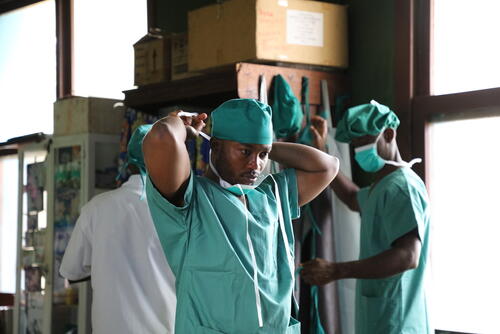Sudan: Children flee hospitals as fighting intensifies in North Darfur
In the five days since intense fighting began between the Rapid Support Forces (RSF), Joint Forces, and Sudanese Armed Forces (SAF) on Friday 10 May, 454 casualties have arrived at South Hospital in El Fasher, North Darfur.
Fifty-six people have succumbed to their injuries, but the death toll and number of wounded are likely far higher. The fighting continues to be so intense that many people cannot reach the hospital.
On the same day of this heavy fighting, we received 160 casualties at South Hospital, including 19 children and 31 women. Twenty-five of the 160 arrived in a critical condition, and sadly passed away as a result of their injuries.
The following day, the fighting started early in the morning. Again, it was close to the paediatric hospital, and it was very intense.
What we need to do now is work out how to ensure that children in a critical condition can continue to receive treatment.
During this fighting, there were a lot of bomb fragments that landed on the hospital. The roof of the ICU collapsed and two children in the ICU died as a result. Many of the caregivers were also wounded. One of them died and one of them lost his leg.
Mass casualty situation
On Sunday, there was again heavy fighting and we received another 130 casualties at South Hospital. Sixteen people died from their injuries and we continue to receive more and more as the fighting continues.
The hospital is overwhelmed and there is a huge amount to do. Some patients have received surgery, but 40 are currently still waiting. If the situation continues like this, I am afraid that we will run out of supplies to handle all these cases.
Currently, the fighting means that we cannot bring in more supplies, so we urgently need safe access and authorisation from the warring parties to be able to do this.
And it is not only that. With the paediatric hospital now out of action, we are one additional hospital down, when there were already far too few operational health facilities available in Sudan.
Continuity of care
The original paediatric hospital was looted at the start of the war, and the children were evacuated to the facility that was impacted by the air strike on Saturday.
This time last year, it was just a small health clinic with not enough space and not enough equipment.
We were asked to rehabilitate it by the Ministry of Health last year, and by June we had expanded its bed capacity and established a neonatal ward, an inpatient department, an inpatient therapeutic feeding centre, as well as a triage area, an outpatient department, emergency room and the ICU where the children were killed on Saturday.
It was full when the fighting started, with some departments over-capacity due to the number of children in need of hospital treatment.
What we need to do now is work out how to ensure that children in critical condition can continue to receive treatment.
South Hospital is full, so the children who were taken there on Friday are in a very busy facility. We are looking into all options, but for now, there is no immediate solution.
What is clear is that the fighting has had a devastating impact on the lives of the civilian population.
MSF and the crisis in Sudan
On Saturday 15 April, intense fighting broke out across Sudan with a wave of gunfire, shelling and airstrikes.
The violence between the Sudanese Armed Forces (SAF) and the Rapid Support Forces (RSF) has trapped millions of people in the middle of an unexpected conflict. Many have been forced to flee their homes while access to essential services such as healthcare has become increasingly difficult.
Médecins Sans Frontières / Doctors Without Borders (MSF) teams already working in Sudan have been responding to the crisis since its first moments.



